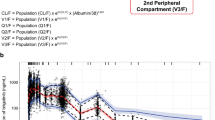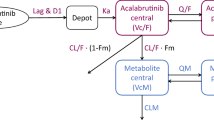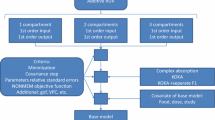Abstract
Background and Objectives
Ibrutinib is an antineoplastic agent that reduces B-cell proliferation by inhibiting Bruton's tyrosine kinase. We describes population pharmacokinetics of ibrutinib in healthy adults, and explores potential patient characteristics associated with ibrutinib pharmacokinetics.
Methods
A population pharmacokinetic modeling approach was applied to 39 healthy subjects. Modeling was performed using Monolix (v.2019R2). Serial blood samples to measure the plasma ibrutinib concentration were collected following the oral administration of 140 mg ibrutinib on two different occasions under fasting conditions. Demographic and clinical information were evaluated as possible predictors of ibrutinib pharmacokinetics during model development. Simulations (using mlxR: R package v.4.0.2) following the administration of therapeutic doses were performed to explore the clinical implications of identified covariates on ibrutinib steady-state concentrations.
Results
A two-compartment model with zero order absorption best fit the data. Inter-individual and inter-occasion variability were quantified by the proposed model. We identified smoking status as a significant covariate associated with ibrutinib clearance. Smoking was found to increase ibrutinib clearance by approximately 60%, which resulted in a reduction in simulated steady-state concentrations by around 40%.
Conclusion
The model can be used to simulate clinical trials or various dosing scenarios. The proposed model can be used to optimize ibrutinib dosing based on the smoking status.




Similar content being viewed by others
References
Wellstein A, et al. Pathway-targeted therapies: monoclonal antibodies, protein kinase inhibitors, and various small molecules. In: Brunton LL, Hilal-Dandan R, Knollmann BC, editors., et al., Goodman & Gilman’s: The Pharmacological Basis of Therapeutics. New York: McGraw-Hill Education; 2017.
Byrd JC, et al. Targeting BTK with ibrutinib in relapsed chronic lymphocytic leukemia. N Engl J Med. 2013;369(1):32–42.
Wang ML, et al. Targeting BTK with ibrutinib in relapsed or refractory mantle-cell lymphoma. N Engl J Med. 2013;369(6):507–16.
Imbruvica, Highlights of Prescribing Information. 2020. https://imbruvica.com/files/prescribing-information.pdf. Accessed 7 Feb 2021.
de Jong J, et al. Single-dose pharmacokinetics of ibrutinib in subjects with varying degrees of hepatic impairment. Leuk Lymphoma. 2017;58(1):185–94.
de Vries R, et al. Stable isotope-labelled intravenous microdose for absolute bioavailability and effect of grapefruit juice on ibrutinib in healthy adults. Br J Clin Pharmacol. 2016;81(2):235–45.
Scheers E, et al. Absorption, metabolism, and excretion of oral 14C radiolabeled ibrutinib: an open-label, phase I, single-dose study in healthy men. Drug Metab Dispos. 2015;43(2):289–97.
de Jong J, et al. The effect of food on the pharmacokinetics of oral ibrutinib in healthy participants and patients with chronic lymphocytic leukemia. Cancer Chemother Pharmacol. 2015;75(5):907–16.
Marostica E, et al. Population pharmacokinetic model of ibrutinib, a Bruton tyrosine kinase inhibitor, in patients with B cell malignancies. Cancer Chemother Pharmacol. 2015;75(1):111–21.
Gallais F, et al. Population Pharmacokinetics of Ibrutinib and Its Dihydrodiol Metabolite in Patients with Lymphoid Malignancies. Clin Pharmacokinet. 2020;59(9):1171–1183.
Neath AA, Cavanaugh JE. The Bayesian information criterion: background, derivation, and applications. WIREs Comp Stat. 2012;4(2):199–203.
Delattre M, Lavielle M, Poursat M-A. A note on BIC in mixed-effects models. Electron J statist. 2014;8(1):456–75.
Lavielle M, et al. mlxR: simulation of longitudinal data. 2015. https://cran.r-project.org/web/packages/mlxR/index.html. Accessed 28 Oct 2020.
Barr PM, et al. Impact of ibrutinib dose adherence on therapeutic efficacy in patients with previously treated CLL/SLL. Blood. 2017;129(19):2612–5.
Stephens DM, Byrd JC. How I manage ibrutinib intolerance and complications in patients with chronic lymphocytic leukemia. Blood. 2019;133(12):1298–307.
Rahmioglu N, et al. Genetic epidemiology of induced CYP3A4 activity. Pharmacogenet Genomics. 2011;21(10):642–51.
Zevin S, Benowitz NL. Drug interactions with tobacco smoking. Clin Pharmacokinet. 1999;36(6):425–38.
Xu RA, et al. Functional Characterization of 22 CYP3A4 Protein Variants to Metabolize Ibrutinib In Vitro. Basic Clin Pharmacol Toxicol. 2018;122(4):383–7.
Acknowledgements
This work has been carried out during sabbatical leave granted to the corresponding author (Mutasim Al-Ghazawi) from the University of Jordan during the academic year 2019-2020.
Author information
Authors and Affiliations
Corresponding author
Ethics declarations
Authors’ Contribution
MA and MS wrote the manuscript and analyzed the data. ON and NN designed the study and supervised the conduction of the study. IS designed the study and supervised bioanalysis of the study samples. All authors contributed towards the critical revision and approval of the manuscript.
Funding
Sabbatical leave granted by University of Jordan to Mutasim Al-Ghazawi.
Data Availability
Data are available on request from the corresponding author.
Conflict of Interest
Mutasim Al-Ghazawi, Mohammad I. Saleh, Omaima Najib, Isam Salem, Naji Najib have no conflict of interest to declare.
Ethics Approval
The study protocol was approved by the institutional review board of the International Pharmaceutical Research Center and the clinical trials Committee at the Jordan Food and Drug Administration.
Consent to Participate
Participants included in the study gave written informed consent before entering the study.
Consent to Publish
Not applicable.
Rights and permissions
About this article
Cite this article
Al-Ghazawi, M., Saleh, M.I., Najib, O. et al. Population Pharmacokinetics of Ibrutinib in Healthy Adults. Eur J Drug Metab Pharmacokinet 46, 405–413 (2021). https://doi.org/10.1007/s13318-021-00679-z
Accepted:
Published:
Issue Date:
DOI: https://doi.org/10.1007/s13318-021-00679-z




